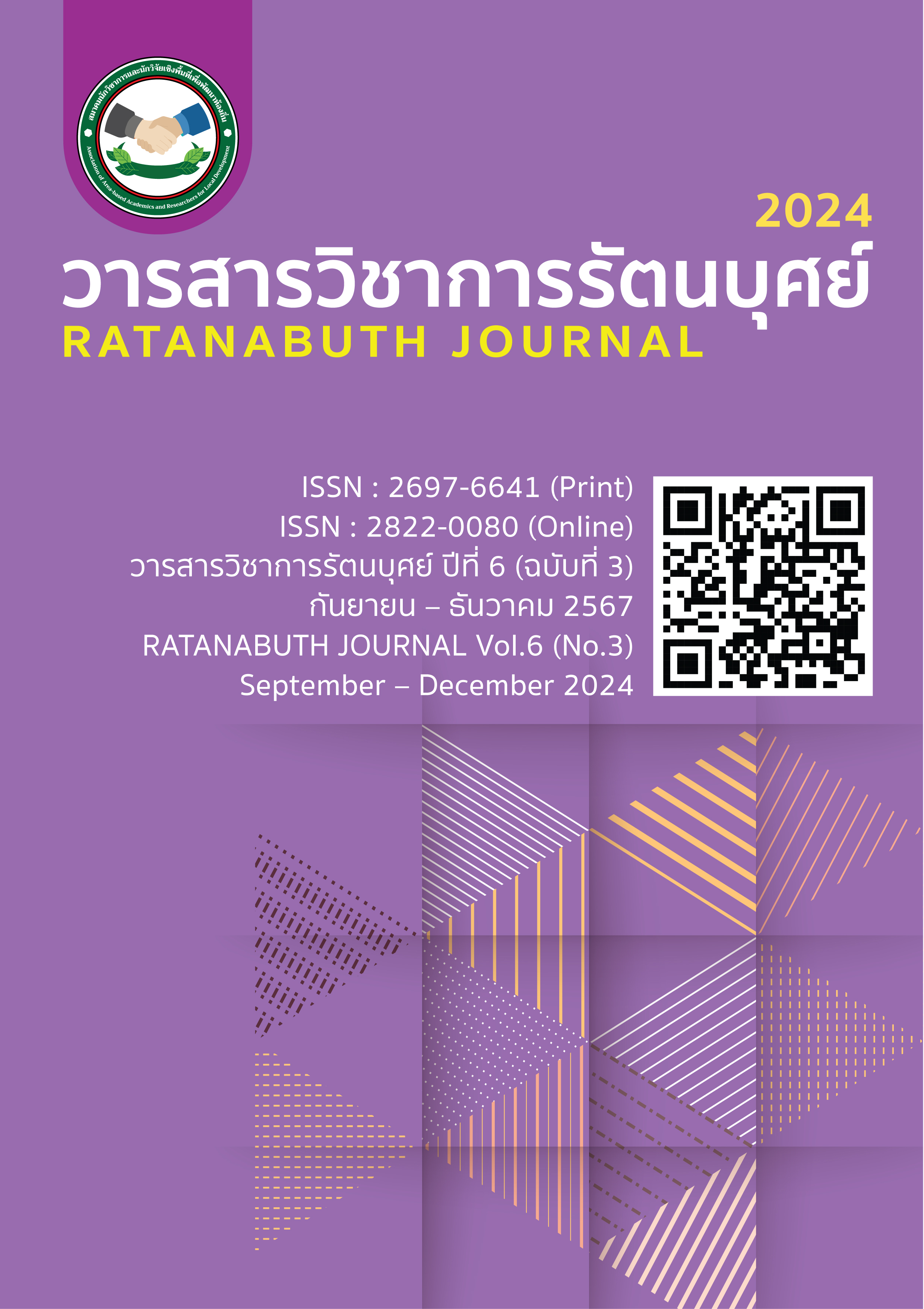Innovation the Wisdom of the Sufficiency Economy to Enhance the Sustainable Competitiveness of Outstanding Community Enterprises. Product Processing Group, Roi Et Province Innovation the Wisdom of the Sufficiency Economy to Enhance the Sustainable Competitiveness of Outstanding Community Enterprises. Product Processing Group, Roi Et Province
Main Article Content
Abstract
This research the objectives are 1) to study the level of innovation creation of Sufficiency Economy wisdom to strengthen the sustainable competitive potential of outstanding community enterprises. Product processing group in Roi Et Province and 2) to study factors affecting the creation of Sufficiency Economy wisdom innovation. To strengthen the sustainable competitiveness of outstanding community enterprises in the product processing group. Roi Et Province. The sample group included community enterprise members of the Ban Non Sawan Community Rice Center. and members of the Pla Ra Bong Herbal community, a total of 73 people, selected specifically Use questionnaires to collect data. Statistics used in the research include analysis of percentages, means, and standard deviations. Statistics used to test hypotheses include Pearson correlation and multiple prediction.
The results showed that
1. The level of innovation in Sufficiency Economy wisdom to strengthen the sustainable competitiveness of outstanding community enterprises. Product processing group In Roi Et Province Overall, it is at a moderate level. Ranked from highest to lowest is support from external networks, followed by leadership of the president/head of the community enterprise group. Knowledge management, organization, personnel management and development Participation and social capital
2. Factors affecting the creation of Sufficiency Economy wisdom innovation to strengthen the sustainable competitiveness of outstanding community enterprises in the product processing group. Roi Et Province There is a positive relationship at the highest level with the creation of Sufficiency Economy wisdom innovation (Y) with statistical significance at the 0.01 level, with a correlation coefficient of 0.918, namely the participation aspect (X4) and the condition aspect. Leadership of the president/leader of the community enterprise group (X3), with both variables being able to predict 88.30 percent.
Article Details

This work is licensed under a Creative Commons Attribution-NonCommercial-NoDerivatives 4.0 International License.
References
กลุ่มประชาสัมพันธ์และเผยแพร่ สำนักโฆษกทำเนียบรัฐบาล. (2561). รัฐบาลพร้อมส่งเสริมวิสาหกิจชุมชนที่จะเป็นกำลังสำคัญที่จะนำพาเศรษฐกิจประเทศไทยให้เข้มแข็ง.สืบค้นเมื่อ 20 ตุลาคม 2566 จากhttps://www.ryt9.com/s/govh/2602212.
กองส่งเสริมวิสาหกิจชุมชนกรมส่งเสริมการเกษตร. (2562). คู่มือการจดทะเบียนวิสาหกิจชุมชนและเครือข่ายวิสาหกิจชุมชน.กรุงเทพฯ : กองส่งเสริมวิสาหกิจชุมชน กรมส่งเสริมการเกษตร.
กองส่งเสริมวิสาหกิจชุมชนกรมส่งเสริมการเกษตร.(2563).คู่มือการจดทะเบียนวิสาหกิจชุมชนและเครือข่ายวิสาหกิจชุมชน. กรุงเทพฯ : กองส่งเสริมวิสาหกิจชุมชน กรมส่งเสริมการเกษตร.
กองส่งเสริมวิสาหกิจชุมชน กรมส่งเสริมการเกษตร. (2560).คู่มือการจดทะเบียนวิสาหกิจชุมชนและเครือข่ายวิสาหกิจชุมชน.กรุงเทพฯ : กองส่งเสริมวิสาหกิจชุมชน กรมส่งเสริมการเกษตร.
จักรพงษ์ นวลชื่น.(2561).แนวทางการพัฒนาวิสาหกิจชุมชนให้ยั่งยืนด้วยภูมิปัญญาท้องถิ่นศึกษากรณี วิสาหกิจชุมชนในจังหวัดนครพนมและจังหวัดสกลนคร. ในรายงานการวิจัยหลักสูตรการป้องกันราชอาณาจักร รุ่นที่ 60 ลักษณะวิชาการเศรษฐกิจ.กรุงเทพฯ : วิทยาลัยป้องกันราชอาณาจักร.
จิตรลดา ตรีสาคร และกฤษดา เชียรวัฒนสุข.(2561).ปัจจัยความสำเร็จที่มีผลต่อศักยภาพการแข่งขันในตลาด AEC สำหรับผู้ประกอบการ SMEs กลุ่มอุตสาหกรรมอาหารแปรรูป ในเขตกรุงเทพมหานครและปริมณฑล. วารสารวิทยาลัยพาณิชยศาสตร์บูรพาปริทัศน์, 13(1),157-175.
จิตพนธ์ ชุมเกตุ.(2560). การจัดการพาณิชย์อิเล็กทรอนิกส์.เพชรบุรี: คณะวิทยาการจัดการ มหาวิทยาลัยศิลปากร.
ธนวุฒิ พิมพ์กิและจันทนา ฤทธิ์สมบูรณ์. (2557). การประยุกต์ใช้แนวพระราชดำริเศรษฐกิจพอเพียงกับวิสาหกิจชุมชน ในจังหวัดจันทบุรี. วารสารวิจัย มสด สาขามนุษยศาสตร์และสังคมศาสตร์ มหาวิทยาลัยราชภัฏสวนดุสิต, 10(1), 1-21.
ธีรศักดิ์ อุ่นอารมณ์เลิศ และคณะ. (2558). การพัฒนารูปแบบการสร้างนวัตกรรมภูมิปัญญาเศรษฐกิจพอเพียง เพื่อเสริมสร้างศักยภาพในการแข่งขันอย่างยั่งยืนของวิสาหกิจชุมชนกลุ่มแปรรูปผลิตภัณฑ์ กลุ่มจังหวัดภาคกลางตอนล่าง. วารสารศิลปากรศึกษาศาสตร์วิจัย, 7(2), 79-92.
บุญชม ศรีสะอาด. (2554). หลักการวิจัยเบื้องต้น (พิมพ์ครั้งที่ 9). กรุงเทพฯ: สุวิริยาสาส์น.
สมคิด บางโม.(2560). องค์การและการจัดการ (พิมพ์ครั้งที่ 7). กรุงเทพฯ : วิทยพัฒน์.
สมทบ แก้วเชื้อ บัณฑิต ผังนิรันดร์และธนพล ก่อฐานะ.(2562). ปัจจัยแห่งความสำเร็จของผู้ประกอบการธุรกิจออนไลน์ในยุคดิจิทัล. วารสารวิชาการเทคโนโลยีอุตสาหกรรมวิทยาลัยนวัตกรรมการจัดการ มหาวิทยาลัยราชภัฏสวนสุนันทา, 15(2), 33-44.
สำนักงานคณะกรรมการพัฒนาการเศรษฐกิจและสังคมแห่งชาติ. (2560). ยุทธศาสตร์ชาติ ระยะ 20 ปี (พ.ศ. 2560-2579). กรุงเทพฯ : สำนักงานคณะกรรมการพัฒนาการเศรษฐกิจและสังคมแห่งชาติ.
สุธาวี กลิ่นอุบล.(2562). การศึกษาการมีส่วนร่วมของชุมชนต่อความสำเร็จในการพัฒนาชุมชนตามแนวทางปรัชญาของ เศรษฐกิจพอเพียง บ้านหัวเขาจีน ตำบลห้วยยางโทน อำเภอปากท่อ จังหวัดราชบุรี. วิทยานิพนธ์รศึกษาศาสตรมหาบัณฑิต.กรุงเทพฯ: มหาวิทยาลัยศิลปากร.
สุวิมล มธุรส.(2564). ปัจจัยความสำเร็จของผู้ประกอบการธุรกิจ ขนาดกลางและขนาดย่อมในเขตพื้นที่ภาคกลางของประเทศไทย. วิทยานิพนธ์บริหารธุรกิจดุษฎีบัณฑิต. ปทุมธานี : มหาวิทยาลัยรังสิต.
อภิชาติ กิตติศักดิ์นาวิน. (2558). การพัฒนาตัวแบบความสามารถการจัดการนวัตกรรมภูมิปัญญาเศรษฐกิจพอเพียงของปราชญ์ชาวบ้าน เพื่อเสริมสร้างการพัฒนาที่ยั่งยืน. วิทยานิพนธ์ปริญญาปรัชญาดุษฎีบัณฑิต สาขาวิชาพัฒนศึกษา.กรุงเทพฯ: มหาวิทยาลัยศิลปากร.
อมรรัตน์ อนันต์วราพงษ์.(2557). รายงานวิจัยเรื่อง รูปแบบการพัฒนาผลิตภัณฑ์ชุมชนบ้านบางหัวเสือตามแนวพระราชดำริเศรษฐกิจพอเพียง. กรุงเทพฯ : มหาวิทยาลัยเทคโนโลยีราชมงคลกรุงเทพ.
Tidd,J.,Bessant,J.,& Pavitt, K. (2001). Managing innovation: Integrating technological market and organizational change. Chicester: Wiley.


